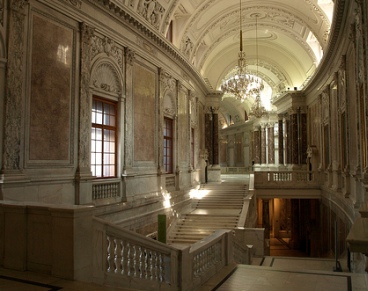

Heldenplatz
Tel. 5252 44031
Open: 10am- 6pm Wed- Mon
Subway: Volkstheater, Herrengasse
Ephesos Museum contains a large collection of artefacts that were discovered during archaeological digs in the ancient town of Ephesus in Turkey. Additionally Ephesos Museum contains a collection of items from the Greek island of Samothrace that was excavated in 1870's. One of the main exhibits in the museum is the colossal frieze dedicated to Lucius Verus's victory over the Parthians in 165 AD.
The collection
Between 1896 and 1906 a total of
seven transports with finds from Ephesos arrived in Vienna. At the
beginning of the 20th century, the finds were exhibited in various
locations, including the Lower Belvedere and the collection of
antiquities in the Kunsthistorisches Museum. In 1911, the temporary
exhibition in the Theseus Temple had to be closed due to damage to
the show pieces. From 1934 to 1944, however, it was used again to
display a selection from the entire collection. From 1947 to 1978,
some ephesian sculptures were shown in the columned courtyard of the
Corps de Logis in the New Castle. It was not until 1978 that all of
the temporary restorations were replaced by the newly designed
Ephesus Museum in the New Castle. As an annex, the museum is
associated with architecture and architectural sculpture from the
mystery sanctuary of the Greek island of Samothrace. In the entrance
area of the museum the architecture of the late classical altar of
the Artemision of Ephesos is built. A staircase leads to a large
hall that contains the frieze of the Parthian monument. Other
important exhibits include a 1: 500 scale model of the ancient city
of Ephesus and numerous sculptures, including the bronze statue of
the athlete.
The Ephesus Museum offers the possibility to
view not only works of sculpture, but also original architecture in
Central Europe away from the ancient centers. Excavations with
Austrian participation are being carried out in Ephesus. The
scientific inventory of the museum inventory is carried out in
cooperation with the relevant Vienna University Institutes, the
Austrian Academy of Sciences and the Austrian Archaeological
Institute.
Some significant exhibits
Amazon from the
Artemision Altar
In the 6th century BC The Temple of Artemi, one
of the seven wonders of the world, was erected. After it burned
down, the new building was surrounded in the 4th century BC. The
sacrificial altar of Artemis Ephesia in front of the temple with a
magnificent surrounding wall. From this comes the top of the wounded
amazon.
Parthian
The Partherdenkmal is the most important
relief work of Roman times in Asia Minor. It glorifies the Roman
emperor and the Roman Empire in five thematic areas. The
reconstruction of the individual plates is not entirely certain,
since they were found in a second or third use. In a reconstruction
proposal, the panels were arranged in the form of a monumental
altar. Of the figure friezes, which were around 70 meters long, 40
meters are on display. In an older interpretation, the monument was
associated with the Emperor Lucius Verus and his Parthian campaign
in AD 161-165 (hence the name). It is more likely that the monument
under Antoninus Pius was erected in the 1940s of the 2nd century AD.
Bronze statue of an athlete
A fragmented Roman copy of a
Greek original from the last quarter of the 4th century BC, showing
a young athlete cleaning his scraping iron, which was used after a
competition to cleanse the body (Apoxyomenos). The statue cannot be
attributed to a specific Greek artist, but was a well-known and
popular motif in ancient times.